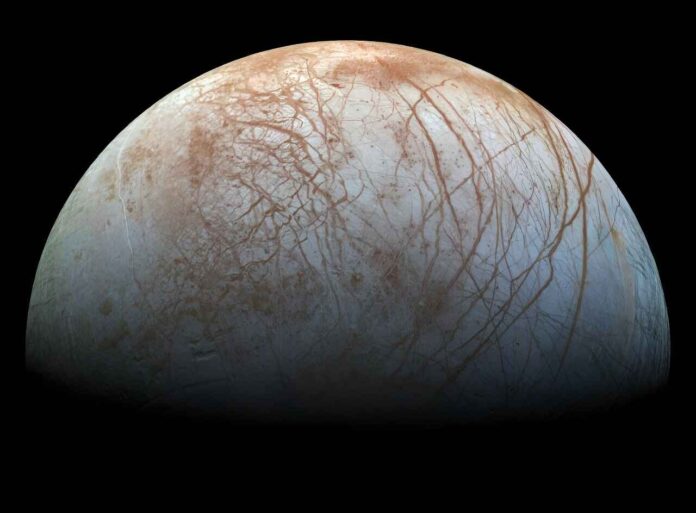Scientists have found evidence that carbon dioxide on the surface of Jupiter’s moon Europa comes from the ocean hidden under its icy shell. This discovery, based on data from the James Webb Space Telescope, could have implications for the potential habitability of Europa’s ocean.
Two US-led teams of researchers used data from the Webb telescope’s near-infrared spectrometer to map CO2 on the surface of Europa, publishing their results in separate studies in the journal Science.
They used a novel method of analysing Mars’ gravitational force that characterises the gravity anomalies caused by surface features. They also used topographic data from the Mars Orbital Laser Altimeter instrument aboard NASA’s Mars Global Surveyor. By combining these data sources, they were able to determine the origin and distribution of CO2 on Europa.
The researchers found that the most CO2 was in a 1,800-kilometre-wide area called Tara Regio, where there is a lot of “chaos terrain” with jagged ridges and cracks. Chaos terrain is thought to be formed by warm water from the ocean rising up to melt the surface ice, which then re-freezes over time into new uneven crags.
The presence of CO2 and salt in this area suggests that these substances came up from the ocean along with the water, indicating that the ocean has a complex chemistry that could support life.
Samantha Trumbo, a planetary scientist at Cornell University and the lead author of one of the studies, told AFP that they favoured the idea that the carbon came from the ocean rather than from carbonate minerals in the planet’s interior. She said that carbonate minerals would require a higher temperature and pressure than what is expected on Europa, and that irradiation would not be enough to break them apart into CO2.
She also said that if the carbon came from the ocean, it would mean that there is a continuous exchange between the ocean and the surface, which could enhance the chances of life.
Europa’s ocean has long been considered a prime candidate for hosting extraterrestrial life in our solar system because it is thought to have liquid water, energy sources, and organic molecules. Previous studies have detected water vapour plumes erupting from Europa’s surface, as well as magnetic anomalies that suggest a salty ocean under a thick ice shell.
The new research provides further evidence that Europa’s ocean has a rich chemistry that could sustain life forms similar to those on Earth or even more exotic ones. Future missions to Europa, such as NASA’s Europa Clipper and ESA’s Juice probe, will aim to explore its ocean and its surface in more detail and look for signs of life.
References:
Samantha K. Trumbo, The distribution of CO2 on Europa indicates an internal source of carbon, Science (2023). DOI: 10.1126/science.adg4155.
G. L. Villanueva, Endogenous CO2 ice mixture on the surface of Europa and no detection of plume activity, Science (2023). DOI: 10.1126/science.adg4270
